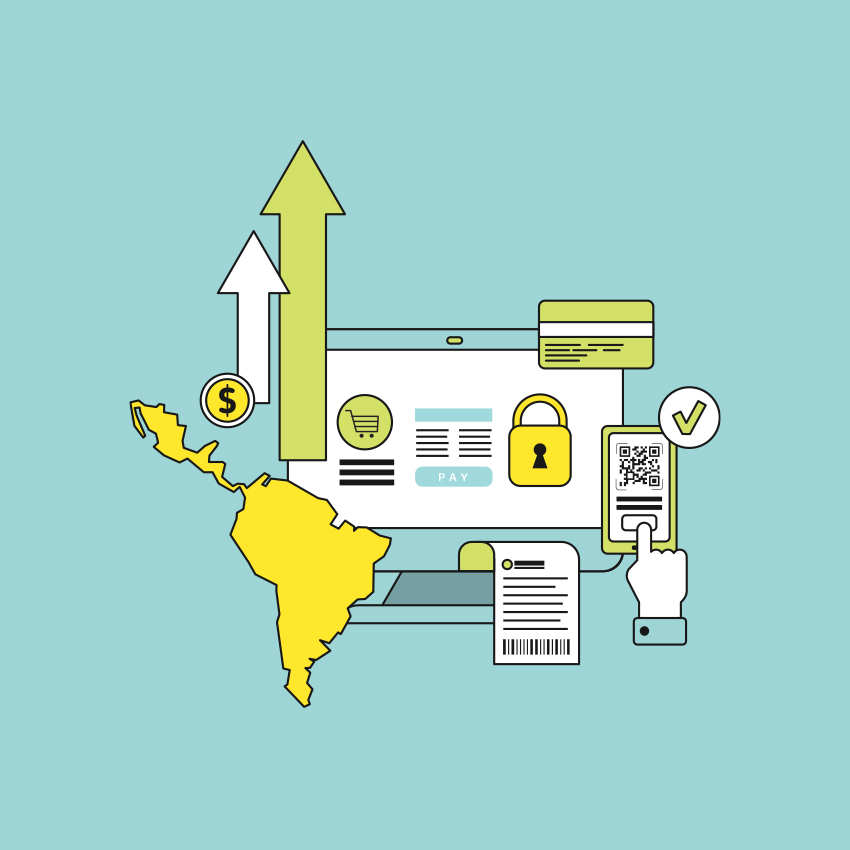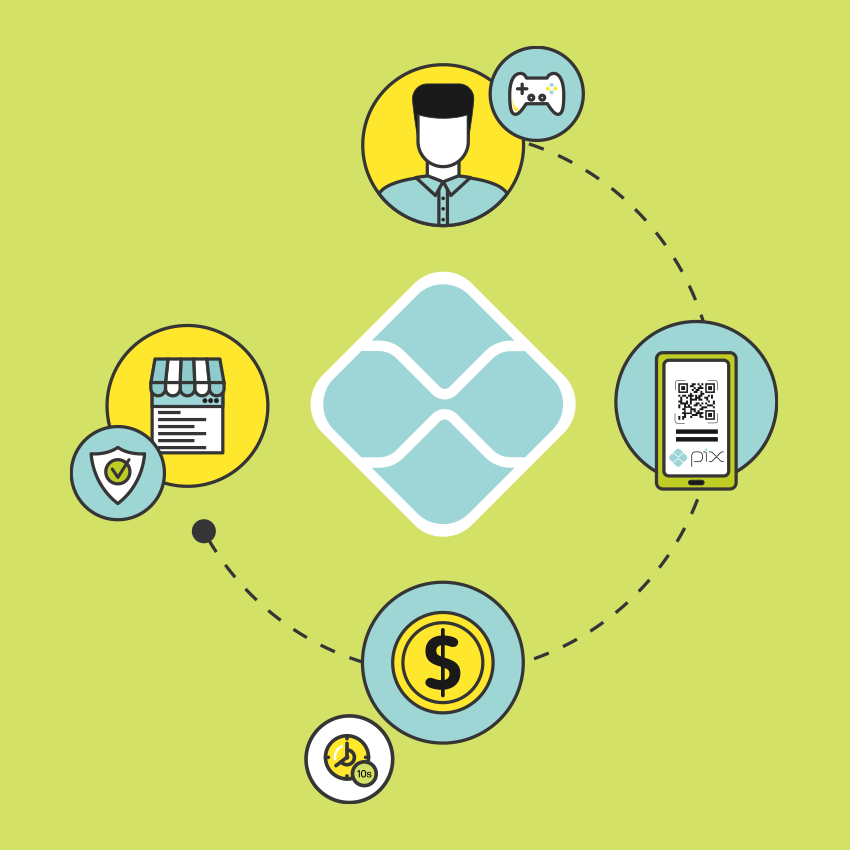From local e-wallets and instant payments to domestic only-credit cards, understand more about current payment trends in the fast-rising market.
After the effects of the coronavirus pandemic in the world and especially in Latin America, the growth of online sales and e-commerce, which were already notorious before, became even stronger and showcased highly fast evolution.
Faced with these transformations, the financial sector that deals with online payment methods has clearly also been affected, bringing in many trends that are beneficial for consumers and companies that aim to increasingly raise their reach on the region.
With this in mind, we have prepared this content to explain the main trends in online payments in Latin America and cite the most used methods with the help of data and research that monitor their evolution in the local scenario.
The evolution of payment methods
With the growth of e-commerce in Latin American countries, many ways to pay for products or services are being created to facilitate the buyer journey and also to help companies close more sales and remain competitive locally.
The penetration of internet users is immense, reaching 171 million and 95 million people in Brazil and Mexico alone, respectively — the two biggest Latam markets. Together, they account for over $ 200 billion out of Latin America's total e-commerce volume of $ 268 billion, in 2021.
The payment methods for making an online purchase are increasingly practical, that is, in constant evolution. According to BoaCompra's Digital Renaissance in Latin America white paper, the growth of some of the latest methods launched on the market, such as Pix in Brazil, will be increasingly common overtime, with Pix expected to account for 31% of all online purchases by 2025.
The 4 most popular payment methods in Latin America
Out of the most varied methods that are already available in the market to make the purchase of a product or service, some are best known by the public and end up being preferred at the time to make a payment. We have listed the main methods used in the Latin American market below.
Credit card
The credit card is still the leader in several Latin American countries and will continue to be for some years. Among all the countries located in Latin America, it loses the lead only in Colombia, where bank transfers are at the top of consumer preferences -- access to credit cards is extremely limited there.
The most commonly used types of cards are domestic-only credit cards, that is, those that do not have their international function activated. We can cite examples such as the national card brands of Brazil (Elo and Hipercard) and Argentina (Naranja). International ones such as Visa and Mastercard are also popular in these countries, but most of the inhabitants do not have that function enabled, and can only make domestic purchases with them.
Other countries, such as Chile, Colombia, Peru and Mexico, have a higher rate of internationally-enabled credit cards. Its use in e-commerces in Latin America exceeds 50%, being 22% from internationally-enabled credit cards, and about 30% of them domestic-only use.
Debit card
Debit cards are popularly used in several countries on the continent, among them Mexico, Chile and Peru, where this payment method in electronic commerce ranks second.
This payment alternative in the Latin American scenario is very strong, but still far from the main ones that perpetuate in the payments market. Its usage percentage reached 11% in 2021 and by 2025 it can hit a 15% mark.
Digital wallets
They are already a very common alternative in the daily life of some countries and will be a trend for this market in the following years. E-wallets are gaining ground in Latin America for their practicality and accessibility for people who are unbanked.
In Argentina, these wallets are already in second place among the most used methods of payment in the country's e-commerces, accounting for 21% of the volume of transactions in 2021. By 2025, this percentage could reach 25%.
In neighboring countries, we can highlight Yape from Peru starting to grow since its foundation in 2016 and Brazil with Mercado Pago, PagBank and PayPal being the most used ones in the territory.
Bank transfers
This method of payment is already part of the daily lives of many people across the Latin American continent and, at the same time, the tendency is that it will increase more and more in e-commerces and in the market as a whole.
In Brazil, Pix is already at an advanced stage and is growing exponentially. The method inaugurated at the end of 2020 by the Central Bank is among the most chosen in the territory, second only to the credit card.
According to the already mentioned BoaCompra white paper, in 2021 Pix represented 15% of payments in virtual stores, leaving more and more traditional methods such as bank slips in disuse -- and the instant payment method is expected to reach 31% of all e-commerce by 2025. Another relevant point is that, among all the percentages of payments, Pix was the only one that showed significant increase.
Other systems from neighboring countries that follow almost the same model of this method are on the rise -- we can mention Sinpe Móvil, in Costa Rica and Yape, in Peru.
Yape, which was created in 2016 by the largest bank in the country, Banco de Credito del Perú (BCP), already has more than 8 million Peruvian users. In 2020, it surpassed a percentage of 60% of the Peruvian banking population.
Sinpe Móvil from Costa Rica was responsible for moving US$ 6 billion in transfers in the year 2021, 4 times compared to the previous year.
3 new digital payments trends in Latin America
Buy Now Pay Later
This payment method is not yet one of the most popular on the continent, but it will gain strength in the following years. The Buy Now Pay Later (BNPL) consists of a term payment method in which the consumer will pay for the product not in cash, but the product can be paid off over a certain period of time without interest, which extends between 12 to 30 months.
Despite being very similar to a credit card, it has a unique differential, which is you do not need to have a pre-established limit in this format. In this way, the person does not need to have a credit card or be an account holder at a financial institution.
According to BoaCompra's analysis, in Latin America, the volume of sales made using this method hit 1% in 2021, expected to rise to 3% in 2025, thus showing a 58% annual growth rate.
NFC
The proximity communication solution, or popularly called NFC (Near Field Communication), allows 2 electronic devices to exchange information just by approaching each other by some centimeters.
Despite already being used in Latin American countries, it is a strong tendency to become increasingly common in the lives of consumers who want to have a more practical experience by paying with their cell phone in bricks-and-mortar locations just by bringing it closer to the card machine in stores. At the same time, such practices encourage a preference for agile and mobile payments, such as Pix.
Cryptocurrencies
Cryptocurrencies are slowly growing and becoming a payment alternative in the main e-commerces operating on the continent. As stated by data from AMI, the partner company for BoaCompra's white paper, 1 in 5 people who are cryptocurrency users make a purchase with them.
Other studies by the company also state that of the 520 Latin Americans interviewed, 1 in 3 individuals have already purchased cryptocurrencies and ⅓ are interested in investing money in this segment.
The future of digital payments
As we could see in the previous topic, there are several trends in online payments, and with each passing day they are more present in the daily lives of the population of Latin America and the rest of the world.
Instant payments as Pix, Yape and Sinple Móvil are gaining in popularity, with the Brazilian system created by the Central Bank being the one that has grown the most compared to other methods.
There are other formats, such as live commerce. This one, which consists of a sales strategy through a live interaction from social networks between the store and the consumer, has also grown a lot and is already widely used by major brands. Relevant studies by AMI indicate that 53% of Latin Americans have already purchased through social networks and 20% of them prefer to shop there.
Now you understand the most popular payment methods in Latin America and the main online payment trends to come. To be part of this moment of digital expansion in Latin America, which brings countless opportunities for companies, get in touch and understand how BoaCompra can help you out:





